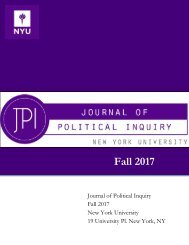JPI Spring 2018
Create successful ePaper yourself
Turn your PDF publications into a flip-book with our unique Google optimized e-Paper software.
third party resources to halt the violence and preserve the combatants. 8 The latter insists that<br />
negotiated settlements are more likely to break down than settlements based on military victory. 9<br />
Barbara Walter, for whom the school of thought is named, argues that “negotiations will<br />
succeed and promises to abide by the terms of the settlement will be credible only if a third party is<br />
willing to enforce or verify demobilization and only if the combatants are willing to extend power<br />
sharing guarantees.” 10 She argues that a ceasefire agreement creates a potentially devastating<br />
opportunity for post-treaty exploitation. Over the short-term, the government and rebels will be<br />
obligated to demobilize, disengage, and disarm their separate militaries to eliminate competing armies<br />
and rebuild a single, national military force. Over the longer-term, combatants will be required to hand<br />
over conquered territory to a new central government, over which neither side would possess full<br />
control. “This dual process creates two opportunities for exploitation, and this is the reason so many<br />
civil wars fail to end with successful settlements,” she argues. 11 The fear of post-treaty exploitation can<br />
convince factions in a civil war to retain their weapons and reject settlements even if both sides would<br />
otherwise prefer peace over armed conflict. In contrast, combatants who are certain that an outside<br />
power will enforce or verify demobilization and are guaranteed leadership in the first postwar<br />
government will voluntarily sign and implement a peace agreement; combatants who lack third party<br />
guarantees will not. 12 Walter calls it a “credible commitment theory.” 13 Therefore, this school strongly<br />
recommends that third parties should provide guarantees of both security and power sharing for<br />
combatants so that those combatants can reach agreements in the first phase. To resolve the<br />
commitment problem, third parties should guarantee combatants’ physical and political safety.<br />
The problem with this hypothesis is that we do not observe it in the real world. For instance,<br />
as we will see in the case study section below, since June 30, 2012 at the Geneva Conference, most of<br />
actors engaged in the Syrian conflict have decided to push for a transnational government in Syria 14 ;<br />
however, both the Assad regime and the rebels have broken the ceasefire agreements and continued<br />
to fight. It seems that both sides made use of the security guarantees that the third parties provided<br />
for them to offend their opponents and to expand their influence over the country instead of<br />
defending themselves. Therefore, we should reconsider what roles the third-party security play in civil<br />
wars. Do they really resolve the commitment problem, or do they worsen it?<br />
The main point of the second school, the Wagner hypothesis, is that even if combatants reach<br />
agreements temporarily, power shifts in favor of the dissatisfied cause conflicts in the future. As time<br />
passes, the power balance among them will change in favor of the dissatisfied, and the dissatisfaction<br />
will explode in the form of military force at some point. 15 If the power balance among the combatants<br />
changes while their aims do not, war may break out. Edward Luttwak further argues that a ceasefire<br />
actually intensifies and prolongs the struggle once it ends because “it tends to arrest war-induced<br />
exhaustion and lets belligerents reconstitute and rearm their forces.” 16 By reaching agreements<br />
8<br />
Monica Duffy Toft, “Ending Civil Wars: A Case for Rebel Victory,” International Security, Vol. 34, No. 4 (<strong>Spring</strong> 2010) p. 7. She called the schools<br />
“Negotiated Settlements” and “Give War a Chance.”<br />
9<br />
Roy Licklider, “The Consequences of Negotiated Settlements in Civil Wars, 1945-1993,” American Political Science Review, Vo. 89, No. 3 (September<br />
1995) p. 685.<br />
10<br />
Barbara F. Walter, Committing to Peace: The Successful Settlements of Civil Wars (Princeton and Oxford: Princeton University Press, 2002) p. 5.<br />
11<br />
Ibid., p. 21.<br />
12<br />
Ibid., p. 33.<br />
13<br />
Ibid., p. 6.<br />
14<br />
Karen De Young, “Syria Conference Fails to Specify Plans for Assad,” The Washington Post, June 30 th, 2012,<br />
https://www.washingtonpost.com/world/national-security/syria-conference-fails-to-specify-plan-forassad/2012/06/30/gJQAsPfeEW_story.html?utm_term=.daf30ac2d843<br />
15<br />
Robert Harrison Wagner, “The Causes of Peace,” in Stopping the Killing: How Civil Wars End, ed. Roy Licklider (New York: New York University<br />
Press, 1993) p. 260.<br />
16<br />
Edward N. Luttwak, “Give War a Chance,” Foreign Affairs (July/August 1999) p. 36.<br />
<strong>JPI</strong> Fall 2017, pg. 42
















